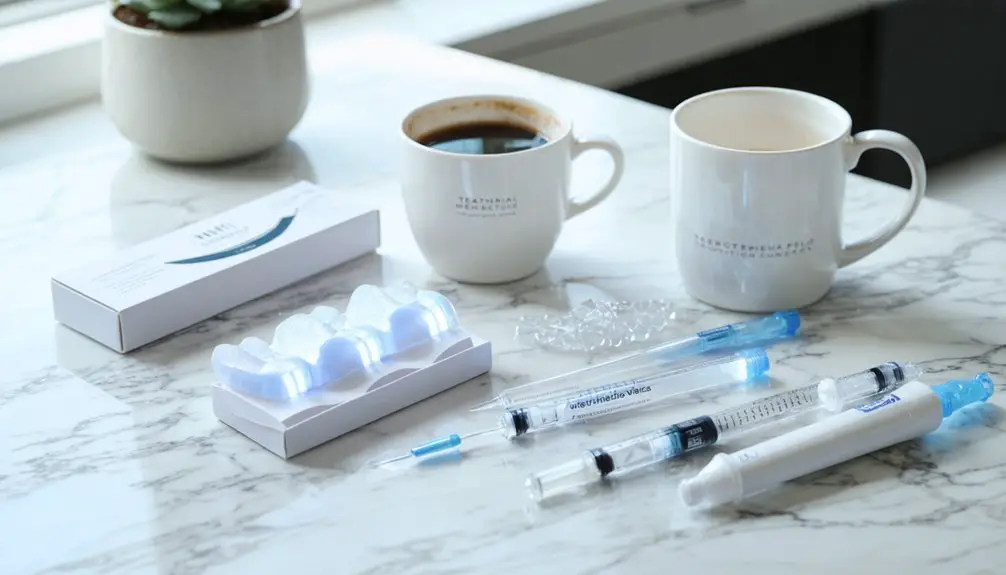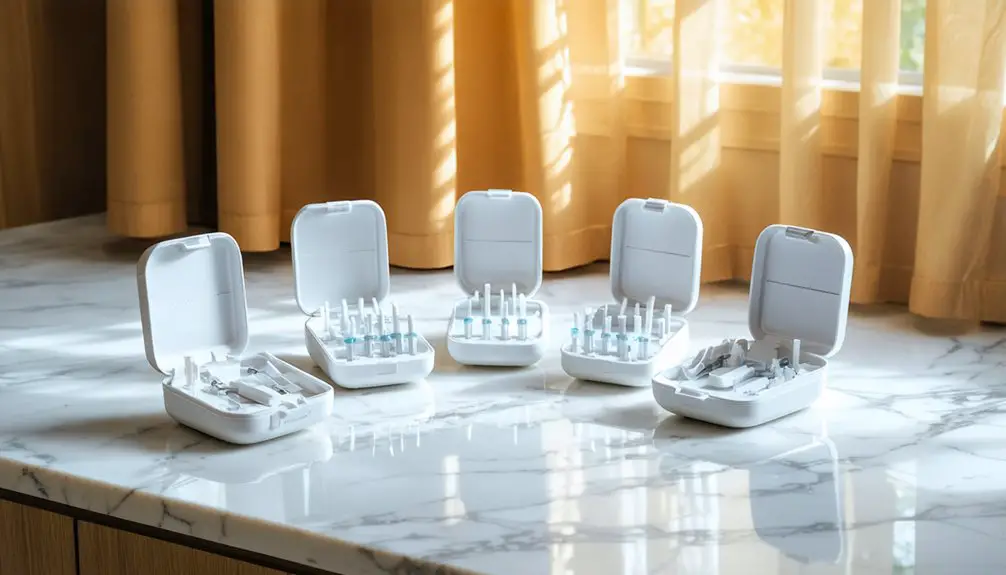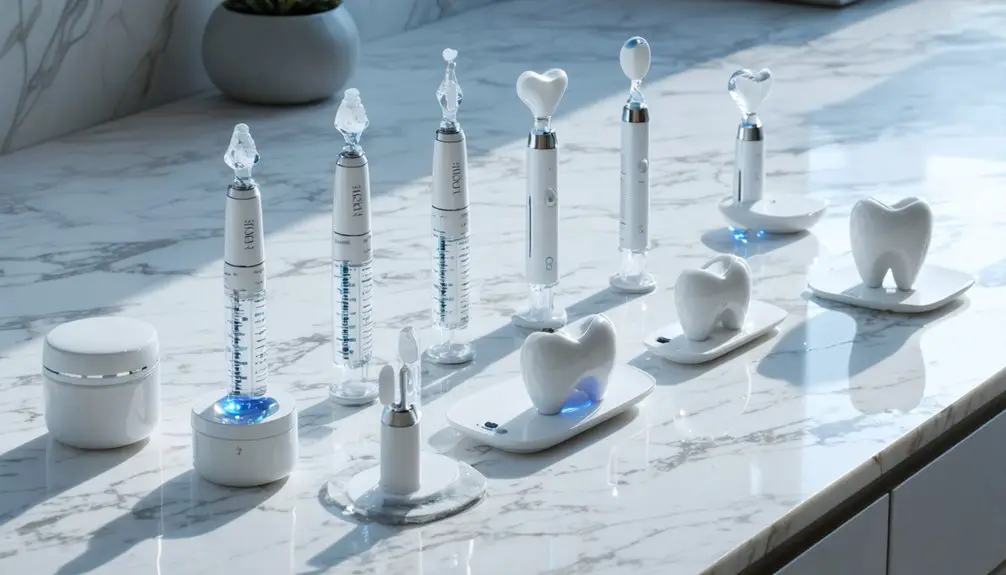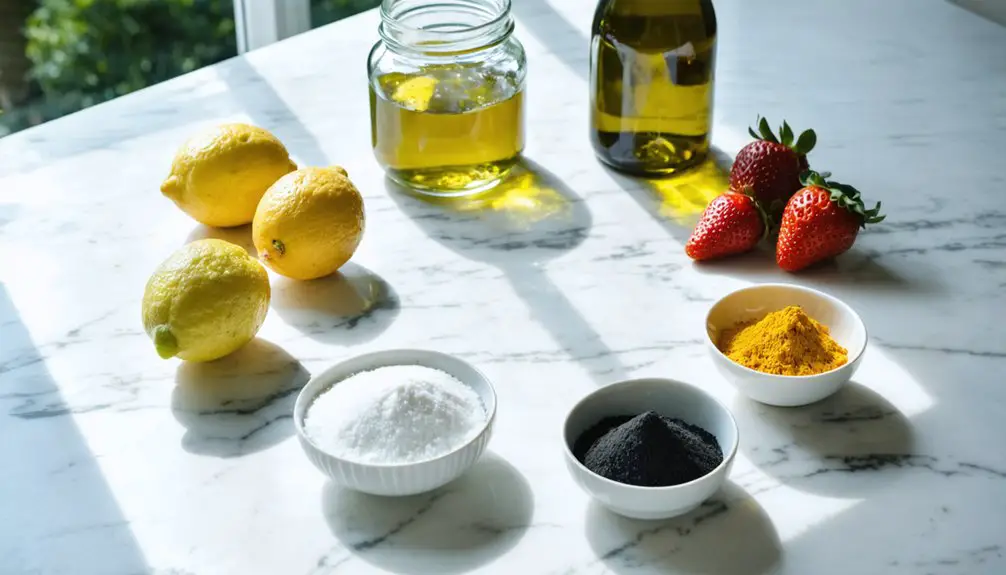For stubborn coffee stains, LED-powered systems like Auraglow and MOON offer the most powerful at-home results, achieving up to 12 shades lighter within two weeks. Custom-fitted trays with professional-grade gels provide deep stain removal, while Crest 3DWhitestrips Sensitive + LED Light delivers gentler yet effective treatment in just 5-30 minutes per session. You’ll need to take into account peroxide concentration levels (3-10%) and treatment duration based on your sensitivity level. Discover how to maintain your results while still enjoying your daily coffee.
Key Takeaways
- Crest 3DWhitestrips Sensitive + LED Light system offers gentle yet effective stain removal for coffee drinkers with sensitivity concerns.
- Custom-fitted whitening trays with professional-grade gel provide even distribution and superior coffee stain removal with minimal gum irritation.
- Auraglow’s LED-powered system can lighten coffee-stained teeth up to 10 shades within seven days of regular use.
- MOON whitening systems deliver up to 12 shades improvement in two weeks, effectively targeting persistent coffee discoloration.
- Over-the-counter whitening strips with peroxide formulations show noticeable results when used daily for 10-14 days on coffee-stained teeth.
Understanding Coffee’s Impact on Tooth Discoloration
While many coffee lovers cherish their daily brew, the beverage’s impact on dental health poses significant concerns for maintaining a bright smile.
Your favorite coffee contains tannins, powerful polyphenols that bind to your tooth enamel and create persistent stains. These compounds work by penetrating microscopic crevices in your teeth, especially when the enamel has been weakened by coffee’s natural acidity.
The process of enamel erosion makes your teeth more susceptible to discoloration over time. When you drink darker coffee varieties like Robusta, you’ll experience more significant staining effects. Recent research shows that black tea causes even more severe tooth discoloration compared to coffee varieties. Sipping coffee slowly throughout the day increases your risk of staining compared to drinking it quickly.
The combination of tannin effects and acidic properties creates a double threat: first weakening your enamel’s protective barrier, then allowing staining molecules to embed themselves more deeply into your tooth structure.
Comparing Professional and At-Home Whitening Options
When confronting coffee-stained teeth, you’ll find two distinct approaches to whitening: professional dental treatments and at-home solutions.
Professional treatments utilize 25-40% hydrogen peroxide concentrations, delivering up to 8 shades lighter in a single 1-2 hour session, though they start at $300. You’ll receive expert supervision to minimize teeth sensitivity and guarantee ideal results. These treatments are particularly effective since they can break down deep chromogen stains from years of coffee consumption.
At-home kits contain 3-10% peroxide, offering a more affordable option at around $50. While they require longer whitening duration of several weeks and achieve 3-6 shade improvements, they provide flexibility in application timing.
However, you’ll need to carefully follow instructions to prevent overuse. Regular dental consultations are recommended since gum irritation and sensitivity are common side effects. Consider your budget, time constraints, and desired results when choosing between these options, as professional treatments offer faster, more dramatic results but at-home kits provide cost-effective alternatives.
Best Over-the-Counter Whitening Strip Solutions
Over-the-counter whitening strips offer a practical solution for coffee-stained teeth, delivering noticeable results through peroxide-based formulations.
When reviewing whitening strip options, you’ll find that ingredient safety varies among products, with hydrogen peroxide and carbamide peroxide being the most common active agents.
The strips use advanced seal technology to maintain close contact between whitening ingredients and tooth surfaces.
- Apply strips once daily for 10-14 days, ensuring proper placement on dry teeth to maximize contact with stained surfaces.
- Expect one to two shade improvements within several days, though results depend on stain severity and consistent use.
- Consider strips with added desensitizing agents if you’ve experienced sensitivity, as 43-80% of users report temporary discomfort.
These products contain lower concentrations of whitening agents compared to professional dental treatments.
For best results, you’ll need to follow application instructions carefully and maintain realistic expectations.
While not as potent as professional treatments, strips effectively target surface stains from coffee when used as directed.
Custom-Fitted Tray Systems for Deep Coffee Stains
You’ll find that custom-fitted tray systems outperform strips by utilizing professional-grade whitening gels with higher concentrations of active ingredients to combat deep coffee stains.
These specialized gels, prescribed by dentists, deliver faster and more dramatic results while reducing sensitivity compared to over-the-counter options. The custom trays offer convenient at-home treatment that fits easily into any schedule.
The precise fit of custom trays guarantees even gel distribution and consistent contact with tooth surfaces, maximizing the effectiveness of each whitening session. Patients experience minimal gum irritation due to the tailored fit of professionally-made custom trays.
Professional-Grade Gel Benefits
Professional-grade teeth whitening gels provide superior stain-fighting power through their concentrated hydrogen peroxide formulations, ranging from 35% to 45%.
These custom gel advantages include stable, potent formulations that penetrate deep into enamel to break down coffee stain molecules through oxidation. You’ll often see visible improvements after just one session, demonstrating peroxide effectiveness against stubborn discoloration. The 44% hydrogen peroxide concentration delivers deeper whitening compared to lower concentrations, making it particularly effective for coffee stains. The gel contains 20% water to prevent tooth dehydration during whitening treatments.
- Dual-barrel syringe systems keep ingredients separate until use, ensuring maximum potency when applied
- Specialized formulations protect enamel integrity while delivering powerful whitening action
- Professional gels maintain consistent thickness for ideal coverage and stain removal
When paired with custom-fitted trays, these professional-grade gels deliver predictable, long-lasting results while minimizing sensitivity and gum irritation – benefits you won’t typically find with over-the-counter alternatives.
Trays Versus Strip Options
When comparing teeth whitening options for coffee stains, custom-fitted tray systems offer distinct advantages over standard whitening strips. Your custom trays’ precise fit guarantees complete contact with all tooth surfaces, even in hard-to-reach areas, while minimizing gel overflow onto gums.
Among trays’ advantages, you’ll find higher-concentration gels that tackle stubborn coffee stains more effectively, delivering noticeable results within one to two weeks. The flexibility to wear trays overnight enables deeper stain penetration than strips’ limited wear time.
Strips’ disadvantages include uneven coverage, especially on crooked teeth, and lower peroxide concentrations requiring longer treatment periods. While strips cost less initially, you’ll save more long-term with custom trays since you’ll only need gel refills for maintenance.
You’ll also experience less sensitivity due to the trays’ precise gel placement.
Natural and DIY Whitening Methods That Work
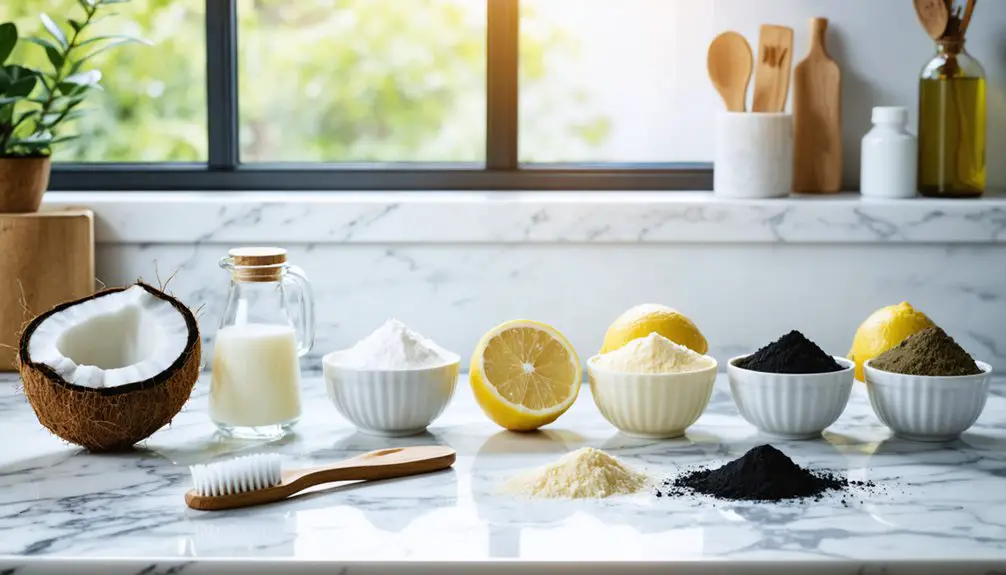
You’ll find several effective natural solutions for removing coffee stains, including a simple baking soda paste that works through gentle mechanical abrasion of surface stains.
When combined with hydrogen peroxide, this paste becomes more potent, offering enhanced whitening capabilities while remaining gentle enough for weekly use.
For those seeking an alternative approach, a diluted apple cider vinegar rinse can break down stubborn stains through mild acidic action, though it should be used sparingly to protect your enamel.
Baking Soda Paste Method
As a time-tested natural alternative to commercial whitening products, baking soda paste offers an effective solution for removing coffee stains from teeth. The mild abrasive properties of baking soda effectively lift surface stains while neutralizing oral acids, making it a gentle yet powerful option for maintaining oral health.
- Mix baking soda with water to create a paste and apply no more than 2-3 times weekly to prevent enamel erosion.
- Brush gently using circular motions, focusing on stained areas while being mindful of gum sensitivity.
- Combine with regular fluoride toothpaste use to guarantee proper cavity protection.
While baking soda’s effectiveness doesn’t match professional whitening treatments, it’s a safe, chemical-free approach that helps reduce plaque, freshen breath, and maintain a healthy pH balance in your mouth.
You’ll notice gradual improvement in surface stains with consistent, moderate use.
Apple Cider Vinegar Rinse
While apple cider vinegar (ACV) has gained popularity as a natural teeth whitening solution, scientific evidence reveals considerable concerns about its safety and efficacy.
Though apple cider vinegar benefits include some antimicrobial properties that may reduce plaque-causing bacteria, its acidic nature poses serious risks to your dental health.
If you’re determined to try ACV for teeth whitening, follow these essential safety guidelines: dilute it considerably with water, limit application to 1-2 minutes, rinse thoroughly afterward, and wait at least 60 minutes before brushing.
However, be aware that repeated exposure can permanently damage your enamel, potentially making teeth more yellow and sensitive over time.
For safer and more effective results, consider dentist-approved whitening treatments or over-the-counter products specifically designed to combat coffee stains.
Hydrogen Peroxide Solutions
Hydrogen peroxide stands as one of the most scientifically validated solutions for removing stubborn coffee stains from teeth.
When using this powerful whitening agent at home, you’ll want to follow precise safety guidelines to protect your enamel and gums while achieving peak results.
For effective and safe whitening with hydrogen peroxide:
- Use a 3% solution diluted with equal parts water to create a gentle mouth rinse or combine it with baking soda for a whitening paste
- Limit application time to 1-2 minutes and frequency to 2-3 times weekly to prevent sensitivity
- Monitor your gums and teeth for any signs of irritation, stopping use immediately if discomfort occurs
Preventing Sensitivity During Home Whitening
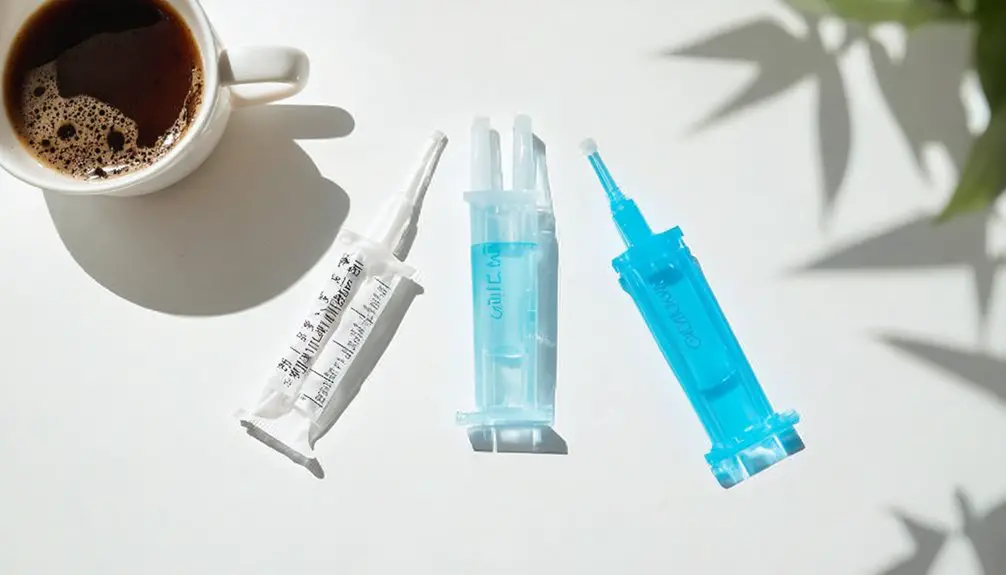
Sensitivity during teeth whitening can substantially impact both comfort and treatment success, making proper prevention essential for at-home users.
For effective sensitivity management, start using desensitizing toothpaste with potassium nitrate 1-2 weeks before treatment, and consider getting a professional fluoride treatment for enhanced enamel protection.
When selecting a whitening kit, opt for products with 5-10% peroxide concentration specifically designed for sensitive teeth.
You’ll want to limit application times to about 5 minutes per session and incorporate rest days between treatments if sensitivity develops.
During the whitening process, take ibuprofen an hour before treatment and avoid extreme temperature exposures.
Use a soft-bristled toothbrush with lukewarm water, and drink through straws to minimize contact with sensitized teeth.
Maintaining Your Results While Enjoying Coffee
For coffee enthusiasts who’ve invested in teeth whitening, maintaining those bright results requires strategic timing and careful consumption habits.
You’ll need to wait at least 48 hours after treatment before enjoying your coffee, as your enamel remains highly porous and susceptible to staining during this period.
To protect your investment while satisfying your coffee cravings:
- Use a straw to minimize contact between coffee and teeth, and rinse with lukewarm water immediately after drinking
- Switch to enamel protection strategies like adding milk to your coffee or opting for lighter roasts
- Consider coffee alternatives like white or green tea during the first week post-whitening
Maintain your results by brushing promptly after coffee consumption and incorporating whitening toothpaste into your daily routine.
For ideal long-term results, limit your coffee intake to one cup daily.
Top-Rated LED Whitening Systems for Home Use
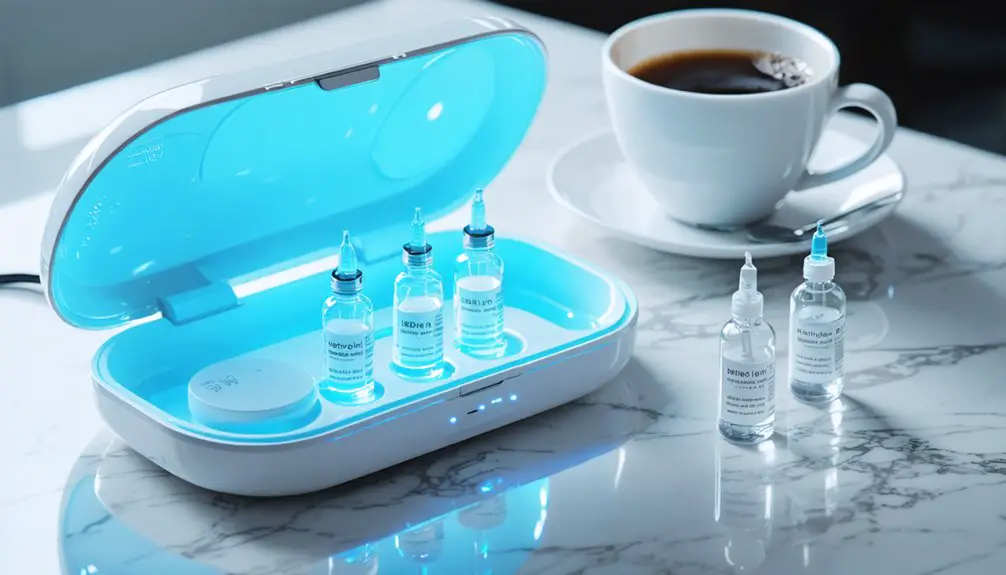
While traditional whitening methods can be effective, LED-powered systems have emerged as the gold standard for at-home teeth whitening, particularly for removing stubborn coffee stains.
Leading options like Auraglow and MOON demonstrate impressive LED effectiveness, with Auraglow’s 35% carbamide peroxide formula achieving up to 10 shades lighter in just 7 days, while MOON’s system promises up to 12 shades improvement in two weeks using quick 5-minute sessions.
For those with sensitive teeth, Crest 3DWhitestrips Sensitive + LED Light offers a gentler approach without compromising results.
The whitening duration varies by product, but most systems require only 5-30 minutes per session.
You’ll find these devices are conveniently rechargeable and portable, featuring blue light technology that accelerates peroxide activation for faster stain removal.
The combination of LED acceleration and clinical-strength peroxide provides professional-grade results in the comfort of your home.
Budget-Friendly Whitening Solutions That Deliver
Although premium LED systems offer advanced whitening capabilities, several budget-friendly alternatives can effectively combat coffee stains without breaking the bank.
Advanced teeth whitening doesn’t require expensive LED systems – affordable options can effectively remove coffee stains while keeping your budget intact.
You’ll find proven options that deliver noticeable results while keeping costs manageable.
- Whitening strips like Crest 3D Whitestrips can lighten teeth by 2.6 shades in 19 days for around $60, offering reliable coffee stain removal with minimal sensitivity.
- Peroxide-based at-home kits priced between $20-$60 provide professional-grade results, with 3-10% hydrogen peroxide concentrations that can lighten teeth 2-4 shades.
- Affordable whitening toothpastes and pens ($5-$30) serve as excellent maintenance tools, preventing new coffee stains while gradually improving overall brightness through consistent use.
These cost-effective teeth whitening solutions give you multiple ways to achieve a brighter smile without compromising quality or results.
Long-Term Strategies for Coffee Lovers’ Dental Care
If you’re a dedicated coffee drinker, you’ll need to combine daily preventive measures like immediate water rinsing and proper brushing techniques with periodic professional whitening treatments to maintain a bright smile.
You can preserve your whitening results by using specialized anti-stain toothpaste, drinking coffee through a straw when possible, and limiting continuous sipping throughout the day.
Consider investing in advanced dental care options such as prescription-strength fluoride treatments or protective sealants to strengthen your enamel against coffee’s acidic effects.
Daily Stain Prevention Tips
Coffee lovers can maintain their pearly whites through strategic daily habits that minimize staining and protect tooth enamel. For effective stain prevention, you’ll want to modify how you consume your coffee and maintain proper oral hygiene throughout the day.
- Use a straw when drinking coffee and finish your cup quickly rather than sipping slowly – this reduces direct contact between coffee and your teeth.
- Rinse with water immediately after drinking coffee, but wait 30 minutes before brushing to protect acid-softened enamel.
- Add milk or cream to your coffee, as dairy proteins bind with staining compounds, or consider coffee alternatives like low-acid varieties.
Remember to stay hydrated and chew sugar-free gum after coffee to stimulate protective saliva production.
These simple adjustments can greatly reduce staining while allowing you to enjoy your daily brew.
Maintaining Professional Whitening Results
Successfully maintaining professional whitening results requires strategic post-treatment care, particularly for dedicated coffee drinkers.
You’ll need to establish a routine that combines proper whitening frequency with daily stain removal practices.
During the critical 48-hour period after treatment, avoid coffee and other staining beverages completely to allow your enamel’s pores to close properly.
Afterward, use a straw when consuming coffee to minimize direct contact with your teeth.
Schedule touch-up treatments every six months using custom-fitted trays, but don’t exceed recommended intervals to prevent sensitivity.
Incorporate hydrogen peroxide-based whitening mouthwash after meals, and maintain consistent oral hygiene with an electric toothbrush for ideal plaque removal.
For enhanced protection, boost your dairy intake and choose crunchy fruits and vegetables to promote natural cleansing through increased saliva production.
Advanced Anti-Stain Dental Options
For dedicated coffee enthusiasts seeking long-term stain prevention, advanced dental options now offer extensive protection beyond standard whitening treatments.
You’ll find professional-grade solutions that effectively combat persistent coffee stains while preserving your enamel’s integrity.
- Protective sealants create a clear barrier against staining, with ideal sealant effectiveness lasting several months before reapplication may be needed.
- Custom-fitted take-home whitening trays provide controlled application of professional-grade bleaching agents, allowing you to adjust whitening frequency based on your needs.
- Low-abrasive whitening toothpastes combined with natural agents like diluted hydrogen peroxide can maintain results between professional treatments.
These advanced options work together to create a thorough anti-staining strategy, particularly beneficial for those who can’t imagine giving up their daily coffee ritual.
Frequently Asked Questions
Can Whitening Kits Remove Decades-Old Coffee Stains From Dental Crowns?
You won’t remove deep coffee stains from crowns with whitening kits because crown longevity depends on their non-porous material, which resists both stain absorption and stain removal through chemical whitening.
How Long Should I Wait After Whitening Before Drinking Hot Beverages?
You’ll need to wait 24-48 hours before drinking hot beverages to prevent whitening sensitivity and protect your enamel. Stick to room-temperature drinks during this time to maintain your treatment’s effectiveness.
Will Whitening Kits Affect the Color of Existing Dental Fillings?
While 80% of adults use whitening products, they won’t change your filling colors. For ideal dental safety and whitening effectiveness, you’ll need to replace fillings after treatment to match your newly brightened smile.
Should I Brush Teeth Immediately Before Applying Whitening Products?
Yes, you should brush before applying whitening products, but wait 3-5 minutes after brushing. This timing optimizes product effectiveness while ensuring proper brushing frequency doesn’t cause sensitivity or enamel damage.
Can I Combine Multiple Whitening Products for Faster Results?
Don’t combine multiple whitening products simultaneously. Due to safety concerns and limited evidence of increased product effectiveness, you’ll achieve similar results using one professional system as directed by your dentist.
References
- https://www.goodhousekeeping.com/health-products/g28723133/best-at-home-teeth-whitening-products/
- https://celebratedentalaustin.com/blogs/teeth-whitening-for-coffee-drinkers/
- https://www.trysnow.com/blogs/news/teeth-whitening-for-coffee-drinkers
- https://thesugarlanddentist.com/blog/whats-the-safest-teeth-whitening-option-for-coffee-drinkers/
- https://www.emmydental.net/ways-to-remove-coffee-stains-from-your-teeth/
- https://www.itjfs.com/index.php/ijfs/article/view/2715
- https://myfortwaynedentist.com/coffee-and-your-teeth-tips-from-your-dentist-sheri-crawford-dds/
- https://pmc.ncbi.nlm.nih.gov/articles/PMC9683888/
- https://www.southernoaksfamilydental.com/blog/beyond-stains-the-impact-of-coffee-on-your-smile/
- https://www.healthline.com/health/dental-and-oral-health/what-does-coffee-do-to-your-teeth
